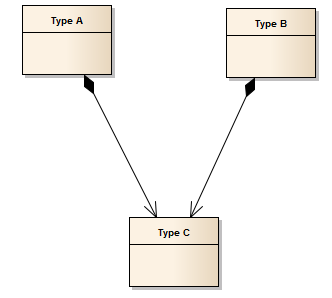Extended Rules
The following sections describe additional rules for updating relationships and assets.
Changing Relationships
As part of the support for Aggregation and Composition, CentraSite allows the relationship form to be changed after the type is created. This change affects all current instances and new instances. This means that after a relationship attribute is created, the form (for association the default form, for aggregation (both forms, that is, using source and using target) and for composite (both forms)) can be changed by an Asset Type Administrator. From that point onwards, the appropriate rules is applied when performing the defined operations.
Updating Assets
The following asset updates need to be taken into account when implementing models:
1. Adding relationships to existing instances. Given the below model:
It is perfectly legal to create instances of Type A and Type B independent of one another. In fact in CentraSite this characteristic is mandatory, as the creation of multiple assets at the same time is only allowed in a few places in the UI.
When adding the relationship between an instance of Type A and an instance of Type B, CentraSite does not do any extra operations to guarantee the consistency of permissions at this point.
2. Adding relationships to 2 different composites. Given the below model (which is a legal model):
The following restriction applies to user-defined asset types, but not predefined asset types: At runtime if an instance of Type A creates a composite relationship to an instance of Type C and then an instance of Type B tries to create a composite relationship to the same instance of Type C, this composition is rejected. This is because a contained asset (instance of Type C) can only have one owning asset (instance of Type A or instance of Type B).


